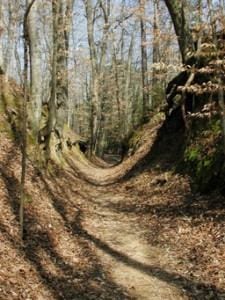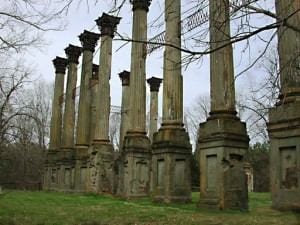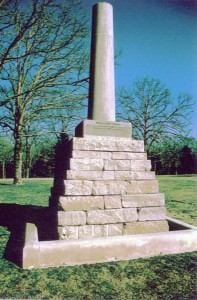Travel Tips
Natchez Trace National Park: Path Through The South’s Past
Natchez Parkway is a 444-mile highway, America’s most linear national park. The park’s headquarters and interpretive center is just outside Tupelo, MS.
The original Natchez Trace Parkway may have been built in an era when cotton was king, but today tourism is one of the area’s main industries. Contributing writer David DeVoss takes on all 444 miles of America’s most linear national park and pinpoints the Mississippi, Alabama and Tennessee landmarks worth visiting along this historic route.
It’s midnight on the Mississippi. In the antebellum city of Natchez, high atop a bluff overlooking the river, lights are winking off in the Victorian mansions and plantation homes emblematic of the Old South. Down on the riverbank, inside the Under-the-Hill Saloon, a dozen yahoos fresh off the Delta Queen are chasing Wild Turkeys with Dixie beer and plotting their next move. For proprietor André Farish Jr., the history of Natchez begins in his saloon: “U. S. Grant may have slept up at Rosalie Plantation, but he spent his evenings down here.”
Under-the-Hill Saloon is just one of the thousands of antebellum structures on this historic route. Understanding the history of Natchez Trace is one element of this national park experience.
Natchez Trace―The Past

Between Natchez and Lower Choctaw Boundary, the eastern bank of the Mississippi is composed of easily eroded loess soil blown down off the plains during the last ice age. The traffic of millions of travelers over thousands of years (Indians were in Mississippi 5,000 years ago) have caused the old trace to sink in several locations.
With an eye toward further westward expansion, President Thomas Jefferson decided to bind Mississippi (and what later would become Alabama) to the rest of the country by transforming a 450-mile forest track called the Natchez Trace into a road for merchants, missionaries and post riders.
The Old Trace zigzagged through canebrakes, skirted Cypress-filled swamps and crossed two large rivers before rising 2,000 feet into the heart of the Eastern Hardwood Forest, an expanse of virgin timber so dense that, according to local lore, a squirrel could travel from Maine to Texas without touching the ground. Homeward-bound Kaintucks needed three to four weeks to walk between the two towns. Post riders took 15 days to carry mail from Natchez to Nashville.
Following the purchase of Louisiana in 1803, traffic on the Trace increased exponentially. By 1810, more than 10,000 Kaintucks each year rode or hiked northward up the Trace. At night they slept in one of 50 roadside “stands” with names like Buzzard Roost and Sheboss Place that advertised “wilderness entertainment” with “great provender and provisions.”
During the first three decades of the 19th century, the Natchez Trace was the Southwest’s most traveled road. Andrew Jackson used it on his victorious return from the Battle of New Orleans. So did former vice president Aaron Burr. The empty brick buildings of Jefferson College in Washington, Miss., where Jackson was feted and Burr acquitted for plotting sedition testify to the former importance of the wilderness highway.
For more of America’s most beautiful places, don’t miss our National Parks section
The Past Meets the Present on the Parkway

Built at a cost of $175,000 by some 600 slaves, the Yankees used the massively ornate Windsor Plantation house during the Civil War, but it was not burned. The house did burn in 1890 when a cigarette accidentally started a fire.
The Natchez Trace Parkway is now a landscaped two-lane highway that parallels the Old Trace. Maintained by the National Park Service, the 444-mile road angles diagonally across Mississippi and nips through northwestern Alabama before cresting the Tennessee Valley Divide and dropping into Nashville’s Cumberland Valley.
It is America’s most linear national park. It’s also one of the most beautiful.
The trip is perfect for families since about every four miles there’s a pull off to a waterfall, picnic ground, nature trail or historical site. But it’s off the parkway in small southern towns that the region’s history truly comes alive.
At the southern end of the parkway is Natchez, a town of 19,000 whose social life and civic identity is rooted in an era when cotton was king. With over 750 antebellum structures and narrow streets designed for carriages the entire downtown is listed on the National Register of Historic Places. Natchez’ biggest industry is tourism, which peaks during the spring Pilgrimage event when dozens of mansions are open to the public.

Monument and gravesite of Meriwether Lewis next to Grinder’s Stand. The broken shaft symbolizes a life interrupted.
Further north on the Trace inside Tennessee at Milepost 386 is the grave of Meriweather Lewis. On the afternoon of October 10, 1809 the hero of the Lewis and Clark expedition pulled into Grinder’s Stand on the Natchez Trace with over $100 in cash. That evening an innkeeper found Lewis shot in the head. His death was declared a suicide, but suspicions arose when the formerly impoverished Grinders moved to western Tennessee with enough money to buy land.
In Vicksburg, it is impossible to escape the memory of the 47-day siege that brought the Gibraltar of the South to its knees. Perhaps that’s because it is impossible to enter the city without passing the federal military park that celebrates the Union Victory. “People who think America has never lost a war don’t realize that many of us have experienced defeat on our own soil,” says Tom Pharr, the 45-year old architect who owns Anchuca, the 1830 Greek Revival mansion that lives on as a centrally-located bed & breakfast.
For a look at Mississippi today, motorists should pull off the Trace at Kosciusko, a town of 7,000 named for the son of a Polish noble who served under George Washington in the Revolutionary war. Kosciusko’s favorite daughter is Oprah Winfrey, but the biggest celebrity attraction on the Trace is the Elvis Presley Center in Tupelo, which includes a museum, gift shop and memorial chapel where the disembodied voice of Elvis sings gospel songs on a continuous loop.
Tips for the Trace
You should know – The 50 mph speed limit on the two-lane Natchez Trace Parkway is strictly enforced, especially in autumn when bicyclists come for the fall foliage.
Must See — You can visit antebellum mansions in Natchez and Vicksburg year around, but during Spring Pilgrimage young women in period costumes lead the guided tours.
Inside Tip – Just west of the parkway 30 miles north of Natchez stand the ghostly ruins of Windsor Plantation. Visit early in the morning or late in the day when wind blowing off the Mississippi River whistles past the charred capitals of the ruin’s 23 Corinthian columns.
For the Gourmet – Natchez’ dry rub barbecue and Tupelo’s catfish are delicious. Also worth a stop is the Tupelo Buffalo Park, a family-oriented zoological park and petting zoo, which sells buffalo steaks.
For more information – See the National Park Service Web site or call the Natchez Trace Tourism Compact at (800) 533-0611 for travel itineraries and historical brochures.
Related links on PeterGreenberg.com:
- Macau, China: World’s Wealthiest Gambling City
- A Belonger Looks back at Hong Kong as its Capitalist Heart Beats On
- America the Beautiful: Five Hidden National Parks
- National Parks section
Text and photos by David DeVoss for PeterGreenberg.com. David DeVoss is editor & senior correspondent of the East-West News Service.












